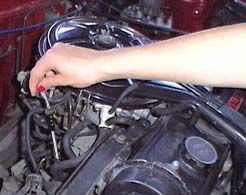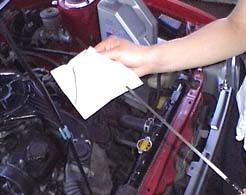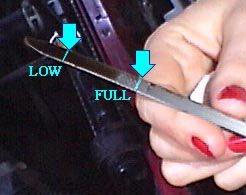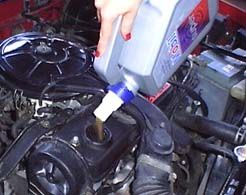Engine Maintenance
The engine is the hearth of your vehicle, and to work well it needs some care. Learn what your engine needs to run longer, why it’s important to change oil regularly and how to check the oil level. This article also covers topics about using synthetic oil versus regular oil and engine tune up. Check few tips how to improve your chances to pass the emission test.
Transmission Maintenance
The automatic transmission is one of the most easy to break and expensive to fix part of your vehicle. Learn what can damage your transmission and what you can do to avoid having problems with your transmission. How to check transmission fluid level and condition, what is an overdrive and when to use it.
How to check the engine oil
 Place your car at a level spot. Stop the engine. Wait for a while to let the engine oil pour down to the oil pan. Pull the engine oil dipstick. If you don’t know where the engine oil dipstick is, check your owner’s manual, usually it has a bright handle saying “engine oil”.
Place your car at a level spot. Stop the engine. Wait for a while to let the engine oil pour down to the oil pan. Pull the engine oil dipstick. If you don’t know where the engine oil dipstick is, check your owner’s manual, usually it has a bright handle saying “engine oil”. Wipe it off with a clean rag or tissue. Then insert it back all the way down into its place.
Wipe it off with a clean rag or tissue. Then insert it back all the way down into its place. Now pull the dipstick again and check the oil level. Normally it should be at the “FULL” mark. For example, here you can see that it’s a bit lower. It’s not a big problem yet, but it’s better to top it up. Check the oil condition: If it’s way too black, it’s definitely time to change it. If it’s slightly brown, it’s O.K. If it’s dark-brown, but still transparent, it’s admissible but it’s better to change it soon. If it’s white (coffee with milk color) it means the engine coolant is mixing with the engine oil because of some internal engine problem, for example, blown head gasket – have your car inspected.
Now pull the dipstick again and check the oil level. Normally it should be at the “FULL” mark. For example, here you can see that it’s a bit lower. It’s not a big problem yet, but it’s better to top it up. Check the oil condition: If it’s way too black, it’s definitely time to change it. If it’s slightly brown, it’s O.K. If it’s dark-brown, but still transparent, it’s admissible but it’s better to change it soon. If it’s white (coffee with milk color) it means the engine coolant is mixing with the engine oil because of some internal engine problem, for example, blown head gasket – have your car inspected. How to top up the engine oil: It would be better to add the same type and brand of the engine oil as you already have in the engine. Ass a little amount of the oil as it’s shown in the image. Wait for a minute to let the oil pour down. Check the oil level again with the dipstick. If it’s still low, add some more. But don’t overfill it. Don’t forget to install the dipstick back and close the oil filter cap when you are finished.
How to top up the engine oil: It would be better to add the same type and brand of the engine oil as you already have in the engine. Ass a little amount of the oil as it’s shown in the image. Wait for a minute to let the oil pour down. Check the oil level again with the dipstick. If it’s still low, add some more. But don’t overfill it. Don’t forget to install the dipstick back and close the oil filter cap when you are finished.
Reduce Your Driving Costs by 25% or More
The cost of commuting, running errands, or vacationing by car has risen sharply with higher gasoline prices, but you can significantly lower your driving costs with these gas-saving tips:
- Don’t drive a gas guzzler. Do you really need that SUV? Six cylinders instead of four? How about that big pickup truck?
- Keep your car properly maintained and tuned. A poorly tuned car can use more than 25% more gas.
- Use steel-belted radial tires. They increase gas mileage up to 10%.
- Don’t use high octane gas unless your car is pinging and knocking or you have a high-performance engine and the manufacturer recommends premium gas.
- Check your tire pressure weekly. For every pound of underinflation, you can lose up to six percent in gas mileage, so if your tires are five pounds underinflated, you’ll use up to 30% more gas.
- Don’t top off your tank when pumping gas. On a warm day, gasoline expands and can overflow.
- Don’t warm your car up by letting it idle. The engine warms up faster when driving than it does when idling, and idling wastes about a quart of gas every 15 minutes.
- Save fuel by combining errands into one trip and avoid backtracking whenever possible.
Wasteful driving habits can double your fuel consumption. Develop gas-saving habits, such as:
- Always accelerate gently.
- Watch traffic ahead of you so you can anticipate slow-downs and avoid stops.
- Coast up to traffic jams by lifting your foot off the gas pedal instead of approaching at full speed and slamming on the brakes. It takes 20% more gas to accelerate to normal speed from a full stop than it does from four or five miles per hour.
- Don’t drive too fast or too slow. It takes 20% to 30% more gas to drive at 70 mph than 50 mph.
- Maintain a steady speed on the highway. Avoid getting stuck behind slow cars where you have to slow down to their pace and then speed up to pass.
Driving Down Dollars (video)
A video will begin playing shortly below:
Regular Checkup (video)
A video will begin playing shortly below:
Safety First (video)
A video will begin playing shortly below:
Vacation (video)
A video will begin playing shortly below:
How often should I rotate my tires?
Your tires should be rotated every other oil change, or every 6000 miles. Neglecting to rotate tires is a major cause of premature tire wear.
Is it really necessary to replace my timing belt at the recommended interval?
YES. The failure of a timing belt in many cars can result in major engine damage. The cost of repairing an engine with a broken timing belt is much greater than the cost of a timing belt replacement.
What does it mean if my “check engine” or “service engine soon” light comes on?
There are many sensors and computerized components that manage your vehicle’s engine performance and emissions. When one of these fails, the “check engine” light is illuminated. Although your car may seem to run fine, it is important to have the issue addressed to prevent long-term problems.
What should I do if my car starts to overheat?
This is a very serious problem – if your car overheats for too long, you can damage your engine. As soon as possible, find a safe place to pull off the road and shut the engine off! Do not attempt to check the fluid level in the radiator as it can burn you. The best thing to do is have your car towed to a repair shop.
When should I get my oil changed?
You should get your oil changed every 3000 miles or as recommended in your vehicle’s owner’s manual.
What is that milky brown engine oil?
Milky brown engine oil is an indication of coolant in the oil. This can be caused by a blown head gasket (other gasket), a failed transmission cooler, or cracked casings. This condition is very serious and needs to be checked by a professional technician quickly.
How to make sure my car battery has a good electrical connection?
Battery cables and terminals should also be cleaned and inspected to make sure they provide a good electrical connection.
What is synthetic motor oil?
Synthetic motor oils can be a good choice for high output, turbocharged or supercharged engines, vehicles that are used for towing (especially during hot weather), or vehicles that are operated in extremely cold or hot climates.
Synthetic motor oils, though several times more expensive than mineral-based motor oils, can improve fuel economy and provide longer intervals between changes. They also provide instant lubrication on start-up.
When should I replace my car’s fuel filter?
To help ensure dependable, trouble-free performance, replace your car’s fuel filter approximately every 30,000 miles or as recommended in your vehicle’s owner’s manual.
When should I change my spark plugs?
For maximum fuel economy and peak engine performance, your spark plugs should be replaced every 30 months or 30,000 miles, unless your vehicle is equipped with 100,000-mile platinum tipped spark plugs.
I need to replace a burned out fuse, what should I do?
Always replace burned-out fuses with ones of the same amperage (printed on the fuse) and note that if a fuse continues to “blow,” you should have the circuit checked professionally by one of our technicians for defects.



